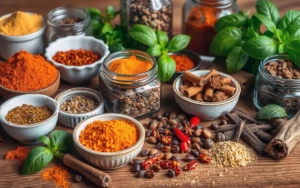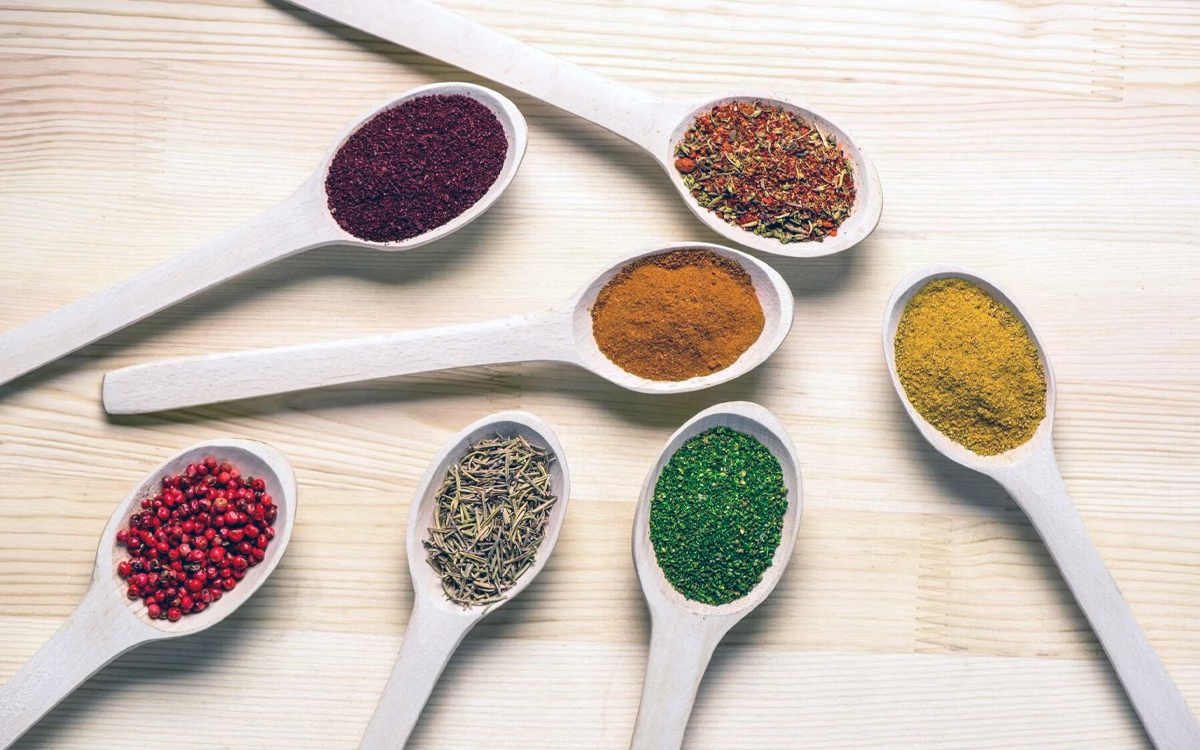The spice rack in your kitchen holds more than just flavor enhancers; it contains natural ingredients with the potential to support well-being. Many spices and herbs are known for their natural wellness potential, offering soothing effects while enriching your meals with bold flavors. This guide takes you through some of the most popular spices and herbs and ways to incorporate them into your daily recipes.
The Natural Wellness Potential of Spices and Herbs
Many spices and herbs contain antioxidants, essential oils, and other bioactive compounds that have been appreciated for centuries in traditional practices. These components may contribute to soothing effects, helping to bring a sense of comfort and balance to your meals and lifestyle. Including these ingredients in your dishes creates a unique culinary experience while aligning with natural wellness principles.
Turmeric – The Golden Wonder with Curcumin
Turmeric’s vibrant yellow hue comes from curcumin, its active compound, widely regarded for its natural wellness potential. Known for an earthy, slightly bitter taste, turmeric complements a range of recipes, from curries to teas.
How to Use It: Add a teaspoon of turmeric to soups, stews, or smoothies for a splash of color and flavor. Try a turmeric latte by blending turmeric with warm milk, a dash of honey, and a sprinkle of black pepper for enhanced taste.
Ginger – A Root with a Zesty Kick
Ginger adds warmth and a peppery zing to dishes, making it perfect for both savory and sweet recipes. Rich in gingerol, ginger has traditionally been used for its comforting and revitalizing properties.
How to Use It: Fresh ginger can be sliced into teas, grated into stir-fries, or added to baked goods for a hint of spice. Its versatility allows it to elevate flavors in marinades, sauces, and even smoothies.
Garlic – Bold Flavor, Big Benefits
Garlic’s pungent flavor enhances a range of dishes, and its active compound, allicin, is notable for its antioxidant properties. Garlic has been traditionally appreciated for its invigorating qualities.
How to Use It: Freshly crushed garlic is ideal for salad dressings, sauces, or spreads. Roasted garlic also brings a mellow, rich taste that complements soups, pasta, and roasted vegetables.
Cinnamon – Sweet Spice with Warming Notes
Cinnamon offers a comforting, warm flavor that enhances both sweet and savory dishes. Known for compounds like cinnamaldehyde, cinnamon has been historically valued for its unique properties that support comfort and balance.
How to Use It: A sprinkle of cinnamon is perfect in oatmeal, yogurt, and coffee. For savory recipes, try adding it to spice rubs for meats or as a fragrant addition to stews and curries.
Rosemary – The Aromatic Herb with Mediterranean Flair
Rosemary brings a pine-like aroma and depth of flavor that’s perfect for Mediterranean-inspired dishes. Rich in essential oils and antioxidants, rosemary is well-regarded for its refreshing nature.
How to Use It: Fresh or dried rosemary pairs well with roasted vegetables, meats, and breads. You can also infuse olive oil with rosemary for an easy, flavorful topping on salads or grilled dishes.
Basil – Fresh, Fragrant, and Flavorful
With its bright, peppery taste, basil is a staple in Italian and Southeast Asian cuisines. Basil contains essential oils like eugenol, which contributes to its pleasant fragrance and culinary versatility.
How to Use It: Fresh basil is a delicious addition to salads, sandwiches, and pasta. Make a simple basil pesto with garlic, pine nuts, and olive oil to elevate your favorite dishes.
Oregano – A Savory Touch with Ancient Roots
Oregano, a staple in Mediterranean cuisine, is packed with antioxidants and compounds like thymol and carvacrol. Known for its earthy and slightly peppery taste, oregano has been used traditionally to complement a variety of dishes.
How to Use It: Sprinkle oregano on pizzas, pasta sauces, and grilled vegetables. It can also be added to marinades or salad dressings for a savory, aromatic touch.

Tips for Using these Spices and Herbs
- Balance Flavors: Different spices and herbs add unique tastes to a dish, so experiment with combining flavors to find a balance that complements your palate.
- Opt for Fresh or Quality Dried Spices: Fresh spices and herbs often retain more of their active compounds. Dried options can be equally beneficial if stored correctly and used before they lose their potency.
- Incorporate in Small Quantities First: Start with small amounts, especially with strong flavors like turmeric or garlic, and gradually add more to suit your taste preferences.
- Try Infused Oils: Create infused oils with garlic, rosemary, or oregano for a convenient way to add anti-inflammatory herbs to your dishes.
Final Thoughts
Spices and herbs are more than just kitchen staples; they are nature’s way of adding wellness to every bite. By incorporating these flavorful ingredients into your meals, you can enjoy a vibrant culinary experience while aligning with your natural wellness goals. Whether it’s the golden hue of turmeric, the zesty kick of ginger, or the comforting aroma of rosemary, each spice and herb bring a unique combination of taste and potential health benefits to your table. Embrace the versatility of these natural wonders and transform your everyday dishes into flavorful, wholesome creations.

